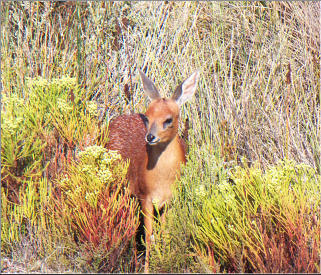



East Cape fynbos
Fynbos is generally confined to the West Cape but we have a special patch between Kleinemonde and the Fish River extending inland towards Grahamstown. This is due to the predominantly sedimentary rock - Witteberg quartzite and sandstone present in the youngest of the Cape Supergroup mountains.Malachite Sunbird
This beauty feasts on the nectar of ericas and leucospermums which dominate this eco-system.Black Harrier
A near endemic and endangered, the Black Harrier prefers to breed in the Cliffortia fynbos.Cape Longclaw
The long hind claw is an adaption that enables longclaws to climb onto grass tussocks to better see prey or danger.



Grysbok also occupy this special niche
being the only mammal totally dependent
on fynbos for survival.

Other plants that thrive in this mainly acid and nutrient poor soil are leucodendrons,
helichrysums, metalasias, watsonias and restios to name a few. These produce a
splash of colour in the winter months.









BRUCE web content & DESIGN

East Cape fynbos
Fynbos is generally confined to the West Cape but we have a special patch between Kleinemonde and the Fish River extending inland towards Grahamstown. This is due to the predominantly sedimentary rock - Witteberg quartzite and sandstone present in the youngest of the Cape Supergroup mountains.Malachite Sunbird
This beauty feasts on the nectar of ericas and leucospermums which dominate this eco-system.Black Harrier
A near endemic and endangered, the Black Harrier prefers to breed in the Cliffortia fynbos.Cape Longclaw
The long hind claw is an adaption that enables longclaws to climb onto grass tussocks to better see prey or danger.




Grysbok also occupy this special niche being the only
mammal totally dependent on fynbos for survival.


Other plants that thrive in this mainly acid and nutrient
poor soil are leucodendrons, helichrysums, metalasias,
watsonias and restios to name a few. These produce a
splash of colour in the winter months.




© AnnesBirding 2016







